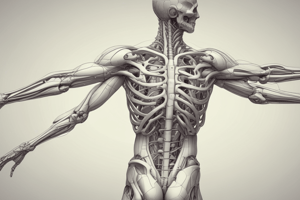Podcast
Questions and Answers
Which bone serves as the primary lever arm for movements like flexion, extension, and rotation in the upper limb?
Which bone serves as the primary lever arm for movements like flexion, extension, and rotation in the upper limb?
- Carpal bones
- Humerus (correct)
- Ulna
- Radius
Which muscle group is responsible for extending the elbow joint in the upper limb?
Which muscle group is responsible for extending the elbow joint in the upper limb?
- Pectoralis major muscle
- Biceps brachii muscle
- Deltoid muscle
- Triceps brachii muscle (correct)
Which bone articulates with the humerus at the capitulum forming part of the elbow joint?
Which bone articulates with the humerus at the capitulum forming part of the elbow joint?
- Ulna
- Humerus
- Carpal bones
- Radius (correct)
What is the primary function of the metacarpal muscles in the hand?
What is the primary function of the metacarpal muscles in the hand?
Which part of the upper limb receives innervation via radial, ulnar, and median nerves?
Which part of the upper limb receives innervation via radial, ulnar, and median nerves?
Which artery provides arterial blood supply to the soft tissues of the hand?
Which artery provides arterial blood supply to the soft tissues of the hand?
What is the primary bone in the shoulder region?
What is the primary bone in the shoulder region?
Which nerve provides innervation to the shoulder region?
Which nerve provides innervation to the shoulder region?
Which artery delivers oxygenated blood to tissues in the shoulder region?
Which artery delivers oxygenated blood to tissues in the shoulder region?
Which muscle is not a major muscle within the shoulder region?
Which muscle is not a major muscle within the shoulder region?
What bones make up the arm segment?
What bones make up the arm segment?
Which joint is supported by the rhomboids and trapezius muscles in the shoulder region?
Which joint is supported by the rhomboids and trapezius muscles in the shoulder region?
Study Notes
Upper Limb Anatomy
Overview
The upper limb, also known as the upper extremity, is a significant part of the human anatomy that plays a crucial role in daily life. Comprising the arm, forearm, and hand, it is responsible for a wide range of movements and functions, including gripping objects, lifting weights, typing on a keyboard, and performing intricate tasks requiring fine motor control.
Shoulder Region
The shoulder region is characterized by several components:
- Bones: The primary bone in this region is the scapula, which provides the foundation for many muscles to attach and contract, allowing for arm elevation, rotation, and movement away from the body.
- Muscles: Major muscles within the shoulder region include the supraspinatus, infraspinatus, rhomboids, trapezius, levator scapulae, teres major, and teres minor. These muscles contribute to the function of the scapulothoracic joint, a physiological joint with the posterior thoracic wall supported by rhomboids and trapezius muscles.
- Transverse cervical, dorsal scapular, and subscapular arteries: These arteries play a vital role in delivering oxygenated blood and nutrients to the tissues in the region.
- Subscapular nerve: This nerve is responsible for providing innervation to the shoulder region.
Arm
The arm segment includes three main parts: the humerus bone, the radius, and the ulna.
- Humerus: This long bone connects the shoulder and elbow regions, serving as the primary lever arm for various movements such as flexion, extension, and rotation—both internal (medial) and external (lateral)—around the longitudinal axis of the forearm.
- Radius: This bone articulates with the humerus bone at the capitulum, forming part of the elbow joint. At the proximal end, the head of the radius participates in the proximal radioulnar joint, contributing to the supination and pronation of the hand.
- Ulna: Articulating with the trochlear notch on the humerus, the ulna's olecranon process fits into the olecranon fossa of the humerus posteriorly, limiting extension movements. The olecranon helps stabilize the elbow joint against hyperextension.
- Triceps brachii muscle: This muscle group is located in the posterior aspect of the upper arm and serves to extend the elbow joint.
Forearm
The forearm segment is mainly composed of three bones: the radius, ulna, and carpal bones (including the scaphoid, lunate, triquetrum, and pisiform).
- Radius and Ulna: These two bones create the wrist joint, which allows for multiple degrees of freedom, specifically flexion, extension, and radial and ulnar deviation. Additionally, the proximal radioulnar joint facilitates supination and pronation of the hand.
- Carpal bones: Located proximally in the hand, these bones make up the wrist and provide structural support for the hand.
Hand
The final component of the upper limb is the hand, which comprises the following elements:
- Phalanges: These small bones serve as the individual finger joints, while the metacarpals connect them to the carpal bones.
- Metacarpal muscles: These muscles contribute to the formation of the hand's grip strength and precision.
- Neural innervation: Each digit receives innervation via the radial, ulnar, and median nerves.
- Arterial blood supply: Terminal branches of the radial and ulnar arteries ensure adequate blood flow to the hand's soft tissues.
By understanding the anatomy of the upper limb, healthcare professionals can better diagnose and treat injuries, identify potential pathologies, and develop rehabilitation strategies to improve patient outcomes.
Studying That Suits You
Use AI to generate personalized quizzes and flashcards to suit your learning preferences.
Description
Test your knowledge of the anatomy of the upper limb, including the shoulder region, arm, forearm, and hand. Learn about the bones, muscles, nerves, and arteries that contribute to the function and movement of this crucial part of the human body.




